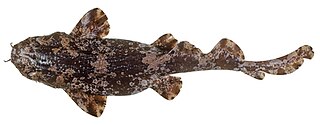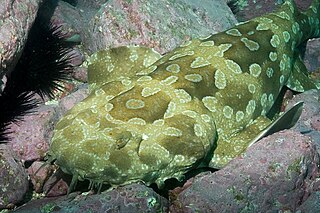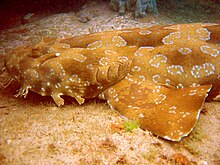
Carpet sharks are sharks classified in the order Orectolobiformes. Sometimes the common name "carpet shark" is used interchangeably with "wobbegong", which is the common name of sharks in the family Orectolobidae. Carpet sharks have five gill slits, two spineless dorsal fins, and a small mouth that does not extend past the eyes. Many species have barbels.

The cobbler wobbegong, Sutorectus tentaculatus, is a carpet shark in the family Orectolobidae, the only member of the genus Sutorectus. It is found in the subtropical eastern Indian Ocean around Western Australia between latitudes 26° S and 35° S. It is frequently found in rocky and coral reef areas. Cobbler wobbegongs reach a length of 92 cm. It has unbranched dermal lobes on the head, rows of warty tubercles along the back and black spots on the body and fins.

The tasselled wobbegong is a species of carpet shark in the family Orectolobidae and the only member of its genus. It inhabits shallow coral reefs off northern Australia, New Guinea, and adjacent islands. Reaching 1.8 m (5.9 ft) in length, this species has a broad and flattened body and head. Its most distinctive trait is a fringe of branching dermal flaps around its head, which extends onto its chin. The fringe, along with its complex color pattern of small blotches and reticulations, enable it to camouflage itself against the reef environment.

The Japanese wobbegong is a carpet shark in the family Orectolobidae of the wobbegong family, found in the tropical western Pacific Ocean from Japan and Korea to Vietnam and the Philippines, between latitudes 43 and 6°N. It reaches a length of 1 m. Japanese wobbegong sharks typically remain motionless during the daytime and are not active hunters. They use camouflage and their electroreceptor pores on their dorsal area to help them sense prey nearby.

The spotted wobbegong is a carpet shark in the family Orectolobidae, endemic to Australia. It is a large, robust species, typically reaching 150–180 centimetres (59–71 in) in length. Coloured green, yellow, or brown, it has distinctive O-shaped spots throughout its body. It is nocturnal, resting at day and feeding on fish and invertebrates at night. An ovoviviparous species, the spotted wobbegong gives birth in the spring, during which time males can act aggressively towards other males and females. It has been known to bite humans, sometimes unprovoked, which can produce severe wounds. The species is fished commercially in Australia, but it is not severely threatened. It is listed as a least-concern species on the IUCN Red List.

The ornate wobbegong is a species of carpet shark that lives in Australia and possibly other countries in the Western Pacific Ocean. It is coloured golden brown, yellow-green and blueish-grey, and it grows to maximum 120 centimetres (3.9 ft). Described by Charles Walter De Vis in 1883, it is similar in appearance to other Australian wobbegongs and has previously been classified as the same species as the Gulf wobbegong. It is a nocturnal species, hunting at night, and it can bite humans when disturbed. The International Union for Conservation of Nature has listed it as a least-concern species.

The northern wobbegong is a carpet shark in the family Orectolobidae, found in the western Pacific Ocean around Australia, between latitudes 9° S to 26° S. It reaches a length of 63 cm.

Orectolobus hutchinsi, the western wobbegong, is a species of carpet shark in the family Orectolobidae. The western wobbegong shark is a moderate sized marine shark found off the coast of Western Australia. Its scientific name is Orectolobus hutchinsi, and it was first identified in 1983 by Dr. Barry Hutchins, but was only recently classified, described, and published in 2006. O. hutchinsi is found on the shallow continental shelf in Western Australia from Coral Bay to Groper Bluff. This species is distinct from other wobbegong sharks because the western wobbegong shark has a yellowish brown upper body and darker brown saddles on their backs. Unlike other wobbegong sharks from the same area, the western wobbegong shark does not have white rings or blotches on their backs.

The Gulf wobbegong or banded wobbegong is a species of carpet shark in the family Orectolobidae, found in southern Australia between Southport, Queensland and Norwegian Bay, Western Australia.

Orectolobus is a genus of carpet sharks in the family Orectolobidae. They are commonly known as wobbegongs, although this name also applies to the other members of the family. They are found in shallow temperate and tropical waters of the western Pacific Ocean and eastern Indian Ocean, chiefly around Australia and Indonesia, although one species occurs as far north as Japan.

The dwarf spotted wobbegong is a carpet shark in the family Orectolobidae, described in 2008. It is found at depths of 9 to 135 metres off south-western Australia. It reaches a total length of 88.5 centimetres (34.8 in).

The floral banded wobbegong is a recently described species of carpet shark found in the Indian Ocean, at depths of 42 to 85 meters, off southwestern Australia. With a maximum length of up to 75 cm (30 in), it is among the smallest wobbegongs. The physical characteristics consist of a striking color pattern of yellowish-brown bands, blotches, spots, and reticulations.

Orectolobus reticulatus, the network wobbegong, is a recently described species of carpet shark found in relatively shallow waters off Kimberley and Darwin in north-western Australia. With a known maximum length of only 52.3 centimetres (20.6 in), it may be the smallest species of wobbegong. Until its description in 2008, it had been confused with the northern wobbegong. The network wobbegong has a short snout, broad head, elongated body, and two dorsal fins, with the first being slightly larger than the second. Its body is grayish brown with darker brown markings and a pale yellow underbelly. The network wobbegong lives in shallow waters along reefy bottoms.

The western gulper shark is a species of squaliform shark discovered in 2008. The species had previously been identified as a variant of the dumb gulper shark, however was differentiated based on morphology. The western gulper is known from the waters of Western Australia, as well as Indonesia, East Timor, and islands in the Southern Indian Ocean. This shark is classified as "least concern" by the IUCN.















